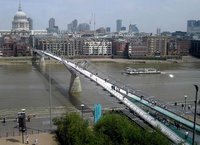 The post-mortem study of the failure of London's Millennium Bridge is in, and sadly, the report does a real disservice to the engineering profession in assessing responsibility for the design's inherent instability. From the Reuters' article "Revealed: Why London’s Millennium Bridge wobbled":
The post-mortem study of the failure of London's Millennium Bridge is in, and sadly, the report does a real disservice to the engineering profession in assessing responsibility for the design's inherent instability. From the Reuters' article "Revealed: Why London’s Millennium Bridge wobbled":
A natural phenomenon rather than a design fault caused London's Millennium Bridge to wobble and sway, forcing its closure just two days after opening in 2000.
The elegant pedestrian walkway was conceived as a blade of light linking the south bank of the River Thames to the City of London.
But as large crowds walked across the steel structure on opening day in June 2000, the 320-meter long bridge swayed from side to side because of a phenomenon known as collective synchronization.
"The phenomenon was that people who were walking at random, at their own favorite speed, not organized in any way spontaneously synchronized," said Steven Strogatz, of Cornell University in Ithaca, New York.
"That's the phenomenon. Why did they all start moving in step? They did it unconsciously. That is what nobody had thought about and engineers did not anticipate."
It would seem from Strogatz' comments that some ancient engineering knowledge has managed to slip past the bridge's designers without being absorbed. By ancient, I mean at least the Romans, whose armies over 2000 years ago would be given the order to "break step" before crossing a bridge. How Stuff Works explains why:
This is to avoid the possibility that their rhythmic marching will start resonating throughout the bridge. An army that is large enough and marching at the right cadence could start a bridge swaying and undulating until it broke apart.
Today, most civil engineers will design bridges to reduce the potential for the occurrence of the resonance effect, including designing the bridge to have a natural frequency (at which resonance can occur) significantly higher than what will be imparted to the bridge through use, or using other strategies for dampening the vibrations that are created.
The Reuters article describes how the effect propagated in the Millennium Bridge:
Certain coincidences must occur for collective synchronization to occur. In the case of London's wobbly bridge, it was large crowds walking across a flexible footbridge that vibrated at a frequency of one cycle per second, which just happened to be the same frequency as humans walking.
So, there it is – an inherent design flaw. Designed to have a natural frequency very close to that of a walking person, all that was needed was a feedback mechanism to produce the resonance effect. To this end, the bridge's motion was such that it sent feedback to every individual walking upon it to effectively "synchronize" their step, making them, without any other outside coordination, into a marching army – thereby amplifying the effect.
After two days of this activity, the authorities closed the bridge until repairs could be made. The bridge has since reopened with considerable reinforcement, both designed to increase the bridge's natural frequency well above that of a walking army, as well as incorporating damping technologies to prevent vibrations from spreading as they had before.
The bottom line – the bridge was poorly designed. No "natural causes" need apply....
Update 7 November 2005: The image of the London Millennium Bridge has been corrected - thanks to commenter Gareth Rees for identifying our error (we had incorrectly included an image of the Gatehead Millennium Bridge.)
Labels: technology
Welcome to the blogosphere's toolchest! Here, unlike other blogs dedicated to analyzing current events, we create easy-to-use, simple tools to do the math related to them so you can get in on the action too! If you would like to learn more about these tools, or if you would like to contribute ideas to develop for this blog, please e-mail us at:
ironman at politicalcalculations
Thanks in advance!
Closing values for previous trading day.
This site is primarily powered by:
CSS Validation
RSS Site Feed
JavaScript
The tools on this site are built using JavaScript. If you would like to learn more, one of the best free resources on the web is available at W3Schools.com.